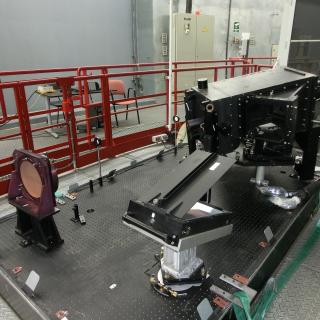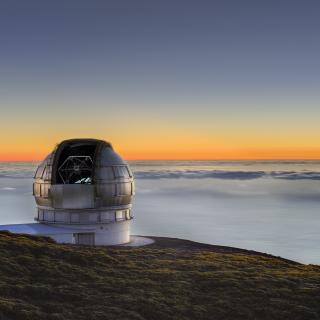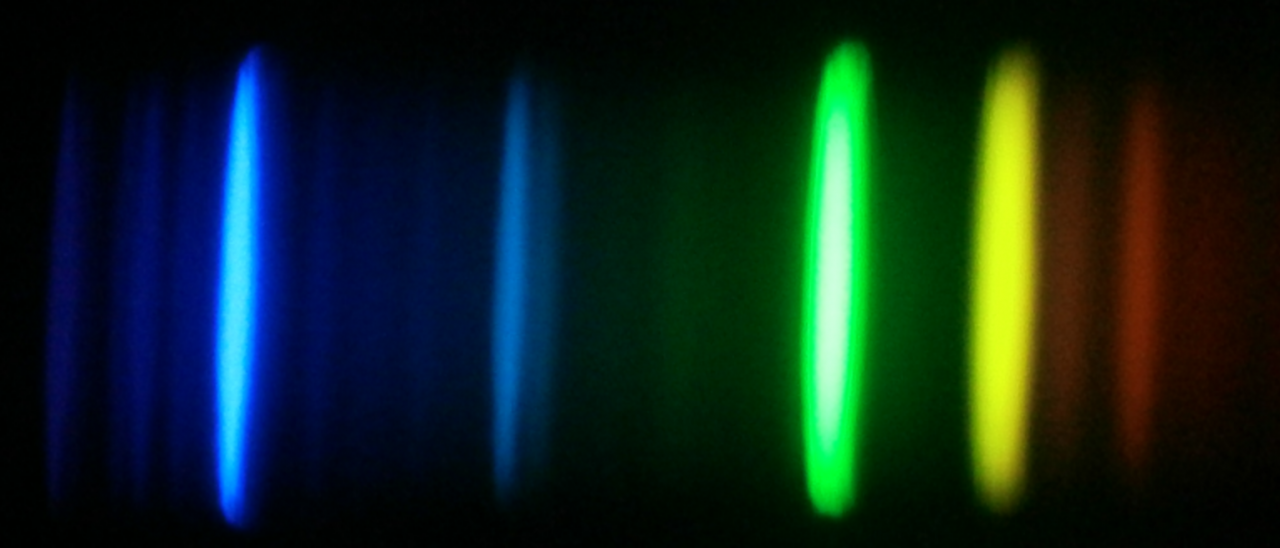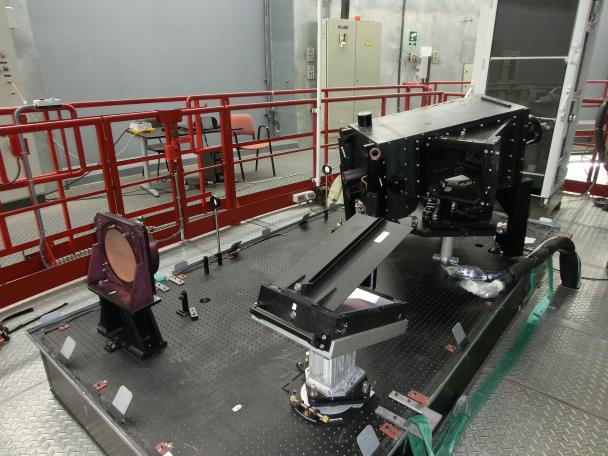Subvenciones relacionadas:
General
La espectroscopía de estrellas nos permite determinar las propiedades y composiciones químicas de las mismas. A partir de esta información para estrellas de diferente edad en la Vía Láctea es posible reconstruir la evolución química de la Galaxia, así como el origen de los elementos más pesados que el boro, forjados principalmente en los interiores estelares. También es posible estudiar la formación estelar, y la de la propia Galaxia, a través de la huella que deja el potencial Galáctico en las órbitas de las estrellas, y de las distribuciones de masa, edad y la abundancia de elementos pesados.
La obtención de espectros con alta resolución espectral, apropiados para estudios de la composición química, requiere instrumentación sofisticada y eficiente. Esto es especialmente cierto en investigaciones en las que se necesitan extensas muestras de estrellas, que exigen observar cientos, o incluso miles de fuentes de forma simultánea. El procesado y análisis de los datos debe ser automatizado para ser igualmente eficiente.
La interpretación de los espectros se basa en modelos físicos de las atmósferas de las estrellas, de donde se escapa la luz que observamos. Los ingredientes fundamentales para la construcción de estos modelos son la dinámica de fluidos, y las propiedades de los átomos, iones y moléculas, especialmente en lo que se refiere a sus interacciones con la radiación que proviene del interior estelar. Una vez que se tiene un modelo plausible, es posible calcular de forma detallada cómo se propaga la radiación a través de la atmósfera estelar, y el espectro emergente, para, de forma iterativa, compararlo con las observaciones y refinar el modelo.
Este Proyecto incluye tres diferentes frentes de investigación:
- La mejora de los modelos de atmósfera y las simulaciones de espectros estelares.
- El desarrollo de herramientas para la obtención, reducción y el análisis de observaciones espectroscópicas, y en particular para la determinación de abundancias químicas en estrellas.
- El diseño, preparación, y ejecución de estudios espectroscópicos de estrellas con el fin de entender a) los aspectos más relevantes de la física de las atmósferas estelares, b) la formación y evolución de las estrellas, c) el origen de los elementos químicos y d) la formación, estructura y evolución química de la Vía Láctea.
Miembros
Resultados
- Completar la instalación y pruebas de HORuS en GTC
- Descubrir dos nuevas estrellas con abundancias de hierro inferiores a 100.000 veces el valor solar
- Completar la clasificación de los espectros de APOGEE con K-means
- Publicar una colección completa de espectros modelo para estrellas O a M
- Identificar la huella de la difusión química en las atmósferas de estrellas del cúmulo M67
Actividad científica
Publicaciones relacionadas
-
The Gaia-ESO Survey: processing FLAMES-UVES spectraThe Gaia-ESO Survey is a large public spectroscopic survey that aims to derive radial velocities and fundamental parameters of about 105 Milky Way stars in the field and in clusters. Observations are carried out with the multi-object optical spectrograph FLAMES, using simultaneously the medium-resolution (R ~ 20 000) GIRAFFE spectrograph and theSacco, G. G. et al.
Fecha de publicación:
52014 -
Chemodynamics of the Milky Way. I. The first year of APOGEE dataContext. The Apache Point Observatory Galactic Evolution Experiment (APOGEE) features the first multi-object high-resolution fiber spectrograph in the near-infrared ever built, thus making the survey unique in its capabilities: APOGEE is able to peer through the dust that obscures stars in the Galactic disc and bulge in the optical wavelength rangeAnders, F. et al.
Fecha de publicación:
42014 -
The Gaia-ESO Survey: radial metallicity gradients and age-metallicity relation of stars in the Milky Way diskWe study the relationship between age, metallicity, and α-enhancement of FGK stars in the Galactic disk. The results are based upon the analysis of high-resolution UVES spectra from the Gaia-ESO large stellar survey. We explore the limitations of the observed dataset, i.e. the accuracy of stellar parameters and the selection effects that are causedBergemann, M. et al.
Fecha de publicación:
52014 -
Chemical Cartography with APOGEE: Large-scale Mean Metallicity Maps of the Milky Way DiskWe present Galactic mean metallicity maps derived from the first year of the SDSS-III APOGEE experiment. Mean abundances in different zones of projected Galactocentric radius (0 R 15 kpc) at a range of heights above the plane (0 |z| 3 kpc), are derived from a sample of nearly 20,000 giant stars with unprecedented coverage, including stars inHayden, M. R. et al.
Fecha de publicación:
52014 -
The SEGUE K Giant Survey. II. A Catalog of Distance Determinations for the SEGUE K Giants in the Galactic HaloWe present an online catalog of distance determinations for 6036 K giants, most of which are members of the Milky Way's stellar halo. Their medium-resolution spectra from the Sloan Digital Sky Survey/Sloan Extension for Galactic Understanding and Exploration are used to derive metallicities and rough gravity estimates, along with radial velocitiesXue, X.-X. et al.
Fecha de publicación:
42014 -
Discovery of Two Rare Rigidly Rotating Magnetosphere Stars in the APOGEE SurveyThe Apache Point Observatory Galactic Evolution Experiment (APOGEE)—one of the Sloan Digital Sky Survey III programs—is using near-infrared (NIR) spectra of ~100,000 red giant branch star candidates to study the structure of the Milky Way. In the course of the survey, APOGEE also acquires spectra of hot field stars to serve as telluric calibratorsEikenberry, S. S. et al.
Fecha de publicación:
42014 -
The Tenth Data Release of the Sloan Digital Sky Survey: First Spectroscopic Data from the SDSS-III Apache Point Observatory Galactic Evolution ExperimentThe Sloan Digital Sky Survey (SDSS) has been in operation since 2000 April. This paper presents the Tenth Public Data Release (DR10) from its current incarnation, SDSS-III. This data release includes the first spectroscopic data from the Apache Point Observatory Galaxy Evolution Experiment (APOGEE), along with spectroscopic data from the BaryonAnders, Friedrich et al.
Fecha de publicación:
42014 -
ESPRESSO: The next European exoplanet hunterThe acronym ESPRESSO stems for Echelle SPectrograph for Rocky Exoplanets and Stable Spectroscopic Observations; this instrument will be the next VLT high resolution spectrograph. The spectrograph will be installed at the Combined-Coudé Laboratory of the VLT and linked to the four 8.2 m Unit Telescopes (UT) through four optical Coudé trainsSantos, N. C. et al.
Fecha de publicación:
12014 -
Identification of red supergiants in nearby galaxies with mid-IR photometryContext. The role of episodic mass loss in massive-star evolution is one of the most important open questions of current stellar evolution theory. Episodic mass loss produces dust and therefore causes evolved massive stars to be very luminous in the mid-infrared and dim at optical wavelengths. Aims: We aim to increase the number of investigatedMorrell, N. I. et al.
Fecha de publicación:
22014 -
New Red Jewels in Coma BerenicesWe have used Sloan Digital Sky Survey-III (SDSS-III) Apache Point Observatory Galactic Evolution Experiment (APOGEE) radial velocity observations in the near-infrared H-band to explore the membership of the nearby (86.7 ± 0.9 pc) open cluster Coma Berenices (Melotte 111), concentrating on the poorly populated low-mass end of the main sequenceWilson, John C. et al.
Fecha de publicación:
22014 -
Doppler imaging of the double-lined active binary V824 AraWe introduce an iterative spectral disentangling technique combined with Doppler imaging in order to recover surface temperature maps for both components of double-lined active binary systems. Our method provides an opportunity to separate spectra of the active components while minimizing the unwanted disturbances on the given line profile from theGarcía-Alvarez, D. et al.
Fecha de publicación:
112013 -
Hypervelocity Star Candidates in the SEGUE G and K Dwarf SampleWe present 20 candidate hypervelocity stars from the Sloan Extension for Galactic Understanding and Exploration (SEGUE) G and K dwarf samples. Previous searches for hypervelocity stars have only focused on large radial velocities; in this study, we also use proper motions to select the candidates. We determine the hypervelocity likelihood of eachSchneider, Donald P. et al.
Fecha de publicación:
12014 -
RATS-Kepler - a deep high-cadence survey of the Kepler fieldWe outline the purpose, strategy and first results of a deep, high-cadence, photometric survey of the Kepler field using the Isaac Newton Telescope on La Palma and the MDM 1.3 m Telescope on Kitt Peak. Our goal was to identify sources located in the Kepler field of view which are variable on a time-scale of a few minutes to 1 h. The astrophysicallyStill, Martin et al.
Fecha de publicación:
12014 -
Infrared Laboratory Oscillator Strengths of Fe I in the H-bandWe report experimental oscillator strengths for 28 infrared Fe I transitions, for which no previous experimental values exist. These transitions were selected to address an urgent need for oscillator strengths of lines in the H-band (between 1.4 μm and 1.7 μm) required for the analysis of spectra obtained from the Sloan Digital Sky Survey (SDSS-IIIRuffoni, M. P. et al.
Fecha de publicación:
122013 -
The SDSS-III APOGEE Radial Velocity Survey of M Dwarfs. I. Description of the Survey and Science GoalsWe are carrying out a large ancillary program with the Sloan Digital Sky Survey, SDSS-III, using the fiber-fed multi-object near-infrared APOGEE spectrograph, to obtain high-resolution H-band spectra of more than 1200 M dwarfs. These observations will be used to measure spectroscopic rotational velocities, radial velocities, physical stellarDeshpande, R. et al.
Fecha de publicación:
122013 -
Discovery of a Dynamical Cold Point in the Heart of the Sagittarius dSph Galaxy with Observations from the APOGEE ProjectThe dynamics of the core of the Sagittarius (Sgr) dwarf spheroidal (dSph) galaxy are explored using high-resolution (R ~ 22, 500), H-band, near-infrared spectra of over 1000 giant stars in the central 3 deg2 of the system, of which 328 are identified as Sgr members. These data, among some of the earliest observations from the Sloan Digital SkyMajewski, Steven R. et al.
Fecha de publicación:
112013 -
Calibrations of Atmospheric Parameters Obtained from the First Year of SDSS-III APOGEE ObservationsThe Sloan Digital Sky Survey III (SDSS-III) Apache Point Observatory Galactic Evolution Experiment (APOGEE) is a three-year survey that is collecting 105 high-resolution spectra in the near-IR across multiple Galactic populations. To derive stellar parameters and chemical compositions from this massive data set, the APOGEE Stellar Parameters andChaplin, W. J. et al.
Fecha de publicación:
112013 -
The Open Cluster Chemical Analysis and Mapping Survey: Local Galactic Metallicity Gradient with APOGEE Using SDSS DR10The Open Cluster Chemical Analysis and Mapping (OCCAM) survey aims to produce a comprehensive, uniform, infrared-based data set for hundreds of open clusters, and constrain key Galactic dynamical and chemical parameters from this sample. This first contribution from the OCCAM survey presents analysis of 141 members stars in 28 open clusters withWilson, John C. et al.
Fecha de publicación:
112013 -
The Protoplanetary Disks in the Nearby Massive Star-forming Region Cygnus OB2The formation of stars in massive clusters is one of the main modes of the star formation process. However, the study of massive star-forming regions is hampered by their typically large distances to the Sun. One exception to this is the massive star-forming region Cygnus OB2 in the Cygnus X region, at the distance of ~1400 pc. Cygnus OB2 hostsGuarcello, M. G. et al.
Fecha de publicación:
82013 -
Very Low Mass Stellar and Substellar Companions to Solar-like Stars from MARVELS. IV. A Candidate Brown Dwarf or Low-mass Stellar Companion to HIP 67526We report the discovery of a candidate brown dwarf (BD) or a very low mass stellar companion (MARVELS-5b) to the star HIP 67526 from the Multi-object Apache point observatory Radial Velocity Exoplanet Large-area Survey (MARVELS). The radial velocity curve for this object contains 31 epochs spread over 2.5 yr. Our Keplerian fit, using a Markov ChainJiang, P. et al.
Fecha de publicación:
92013
Charlas relacionadas
No se han encontrado charlas relacionadas.Congresos relacionados
No se han encontrado congresos relacionados.Noticias








